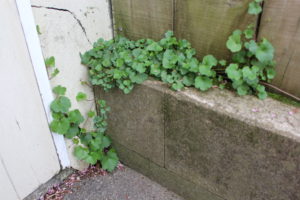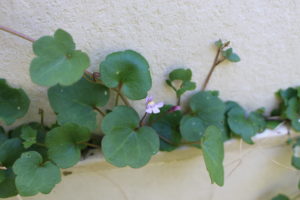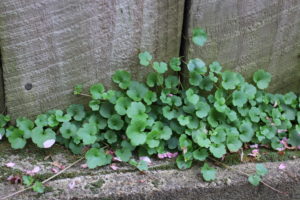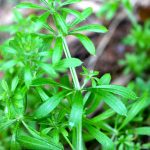
Ivy leaved toadflax
I’ve only just learned that this month’s feature ‘weed’ is edible. Ivy leaved toadflax (Cymbalaria muralis) has a number of other names such as Kenilworth Ivy (because it covered the walls of Kenilworth Castle in the UK), Oxford Ivy, Mother of Thousands or Wandering Sailor and is a garden escape originating in Southern Europe. It is a trailing, hairless, perennial plant that commonly grows in rock or wall crevices (as its Latin name muralis indicates), up shady banks, or over paths. Its leaves are ivy shaped with five lobes, hairless and approximately 1cm in diameter. Pretty two-lipped mauve flowers with a yellow or whitish pouch emerge all year from Jan-Dec. They look like much smaller versions of snap dragons.
Ivy-leaved toadflax’s lacelike stems can grow up to 80cm long. It has a remarkable method of propagation. The flower stalk starts out as positively phototropic meaning they grow towards the light to

Ivy leaved toadflax flowers
attract pollinating insects. Once fertilised the flower stalk becomes negatively phototropic and moves away from the light into dark cracks and crevices where the seeds germinate. This habit however, can be destructive. I found it growing behind a temporary repair patch on my garage wall. It was actually pushing the patch off, mind you it wasn’t well attached. I was amazed at the amount of plant I pulled out from behind the patch. I better keep an eye on that.
I don’t want to get rid of it however, as I find it a dainty, pretty plant and in addition, you can eat it. It is a nice addition to salads, especially at this time of year to help with spring cleaning our bodies.
Ivy-leaved Toadflax is high in Vitamin C. It tastes pungent and acrid but is great mixed in with other greens. It is said to have been used in India to treat diabetes.

Ivy leaved toadflax
So why is a Toadflax called a Toadflax? The answer is lost in history, but one explanation is that the flower looks like the wide-mouthed face of a toad. Another is that the flower looks like a whole toad! There is also a theory that toads liked to shelter amongst the leaves, and given that they like the crevices in drystone walls, seems to the likeliest explanations. We don’t have toads but now I’ve discovered this plant I start to see it in lots of places.
Wild Edible Salad
Pick leaves of the following: Lambs lettuce (Valerianella locusta), miners lettuce (Claytonia perfoliate), arugula (Eruca vesicaria ssp. Sativa), twin cress (Lepidium didymium), chickweed (Stellaria media), ivy-leaved toadflax (Cymbalaria muralis), oxalis or sorrel leaves (Rumex acetosella). Make a nice vinaigrette dressing and voila instant salad. Decorate with toadflax flowers.
‘The flavours you get from these pungent, lemony, bitter, sweet wild leaves are unlike anything you get from a polytunnel. They taste the best because this is when they are meant to be grown and picked – in their natural environment.’Caprice Holdings’ Chef director Mark Hix, London.



